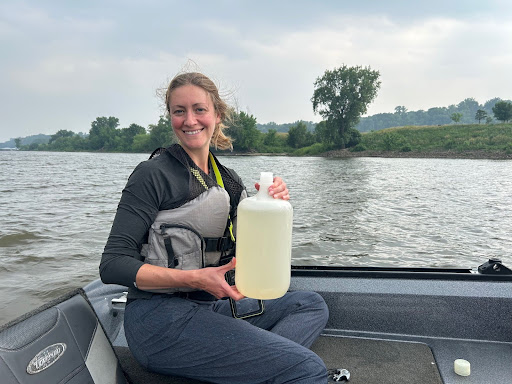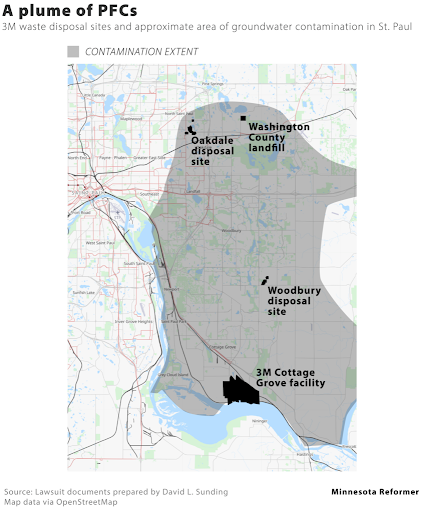What’s at stake in MN’s first industrial PFAS wastewater permit
By MCEA Water Program Director, Carly Griffith

Photo of Carly Griffith taking water samples to test for PFAS, Summer 2023
When I first started at MCEA, I was excited to be part of efforts to protect Minnesota from the dangers of PFAS and hold the corporate polluters behind its ubiquity accountable. As the home of 3M’s corporate headquarters – one of the first manufacturers of what we now know to be toxic “forever chemicals”– Minnesota has a distinct responsibility in this fight. We also have an opportunity to show the rest of the country how to remediate PFAS in the environment and make sure corporations like 3M pay for it.
I watched Minnesota rise to the occasion in 2023, when, led by the bravery of Amara Strande and supported by the advocacy of organizations like MCEA and Clean Water Action, our state passed the most comprehensive ban on PFAS in the nation. Strande died shortly before the bill passed from a rare cancer she attributed to her PFAS exposure. She grew up in Washington County near an underground PFAS plume caused by 3M’s Cottage Grove facility.
Minnesota is now on the verge of another important step in the fight: adopting Minnesota’s first industrial wastewater permit with limits on PFAS pollution. If done right, this could set a precedent for other wastewater permits across the state and dramatically reduce the amount of PFAS in one of the primary pathways it currently enters our lives and ecosystem: wastewater streams.
The permit, which was released by the Minnesota Pollution Control Agency (MPCA) earlier this summer and is still in draft form, aims to specifically regulate PFAS levels in wastewater discharged at 3M’s Cottage Grove facility. This means, if approved, the company would have to pay for treatment systems that dramatically reduce the amount of PFAS in its wastewater before it can be discharged out of its facility.
It’s long overdue. Over fifty years overdue, to be precise. That’s because it was in 1951 that 3M first started to commercially produce PFOA at its Cottage Grove plant – a compound that we now know is carcinogenic and toxic to humans at shockingly low levels measured in parts per trillion. The production of many other PFAS compounds at the 3M Cottage Grove plant would follow, and continues today.
The impact of PFAS pollution from chemical manufacturers like 3M has since reached every corner of the globe, with the chemicals now found in polar bears, Norwegian arctic ice, and the Tibetan plateau. The impact also hits close to home: here in Minnesota, the 3M Cottage Grove facility and 3M waste disposal sites in Washington County have contaminated drinking water supplies and led to elevated PFAS levels in the stretch of the Mississippi River where the Cottage Grove plant discharges.

In fact, 3M’s Cottage Grove facility discharges an average of 5-6 million gallons of wastewater a day into the Mississippi River, making it a major source of PFAS into a prized waterway that provides critical fish and wildlife habitat and provides drinking water to downstream communities.
Just last year, a report was released on the high levels of PFAS located in the stretch of the river the Cottage Grove plant discharges into: levels so high the Minnesota Department of Health warned pregnant and breastfeeding women as well as children under 15 not to eat fish from the area.
Then in May, the Minnesota Pollution Control Agency (MPCA) used this data to set site-specific water quality criteria for six PFAS compounds in the same section of the river. These criteria establish the specific PFAS levels in the river and in fish tissue that cannot be exceeded in order to protect human health. These site-specific criteria were used as a regulatory tool to set pollution limits for those same six PFAS compounds in wastewater that the 3M Cottage Grove plant discharges to the river through the draft wastewater permit.
3M withheld information about the health effects of the PFAS chemicals for decades. Now we have the opportunity to hold the corporation accountable for its clean up by approving a permit that is as protective as possible. Minnesota has to get this right, not only to ensure 3M’s accountability, but because we know this permit will set a precedent for how we regulate PFAS in other industrial and municipal wastewater treatment plants across the state.
That’s why MCEA researched and submitted a detailed comment to MPCA demanding a permit that leaves no wiggle room for 3M and forces them to meet pollution limits that are near non-detect levels. It’s why we pushed the state to extend its comment period to the end of this month so that the public has ample time to weigh in on this complicated process.
If you’d like to write your own comment, I urge you to do so: the more that Minnesotans speak up to demand corporate accountability for PFAS pollution and the harm it has caused our communities, the more the tides will start to shift in that direction. You can submit an individual comment here until midnight on August 30.
It was through our collective efforts that we passed Amara’s Law, which is the most effective way to reduce PFAS pollution long-term because it forces industry to find workable alternatives to PFAS for their products.
Now we have to focus on ways to remediate the PFAS that are already here and everywhere to better protect public health and our environment. Adopting strict wastewater permit limits that will require 3M to treat its wastewater to near non-detectable levels is key to our success.
WHAT ARE PFAS
PFAS are a family of over 1,000 synthetic chemicals that repel heat, water, and oil and have been used for decades to produce consumer products from raincoats and dental floss to medical devices. PFAS are now linked to serious human health effects like various forms of cancer, thyroid disease, and adverse birth outcomes. In fact, just this year the Environmental Protection Agency (EPA) passed the first ever federal standards for PFAS in our drinking water because of their impact on human health.
WHAT IS AMARA’S LAW AND HOW WILL IT WORK
Amara’s Law is a bill that passed the Minnesota Legislature in 2023 that will eventually “turn off the tap” on PFAS by prohibiting the sale of consumer products with non-essential uses of PFAS in Minnesota by 2032. It is the most effective way to reduce PFAS pollution long-term because it forces industry to find workable alternatives to PFAS for their products.
The bill was named after Amara Strande, a young woman who championed the bill while struggling with a rare cancer she attributed to her PFAS exposure growing up near the underground PFAS plume in Washington County caused by 3M. Amara died shortly before the bill was passed.